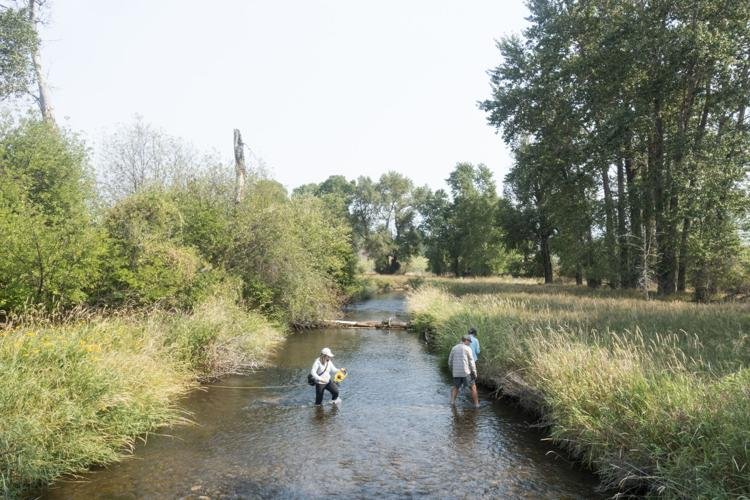Putting in the work: Volunteers take on stream monitoring in the lower Gallatin watershed
By Helena Dore Chronicle Staff Writer
Link to Bozeman Daily Chronicle Article
If it weren’t for a dedicated crew of volunteers, Torie Haraldson wouldn’t have enough time or staff to monitor water quality and quantity in the East Gallatin River and its tributaries.
Fortunately, members of the Gallatin Streams Team regularly spend their free time measuring flows, water temperatures, bacteria levels, conductivity, pH and algae growth across the lower Gallatin River watershed.
During the summer months, the fleet of volunteers goes to spots scattered throughout the northern portion of Gallatin County. They spend hours taking water quality and quantity measurements at the sites.
Torie Haraldson, water quality specialist with the Gallatin Local Water Quality District, writes notes while working on Hyalite Creek near its confluence with the East Gallatin River on Thursday, August 26, 2021. The Gallatin Local Water Quality District recruits volunteers to build data sets about stream flow, temperature and particulates.
Once a volunteer herself, Haraldson is now a water quality specialist with the Gallatin Local Water Quality District. She leads the team of citizen scientists. Their fieldwork helps inform the district’s Surface Water Monitoring Program.
Rapid growth in the Gallatin Valley could be impacting surface water quality, but data has mostly been short-term and project-specific, according to Haraldson. To better assess pollution trends, the district needs people to go out and regularly collect long-term data.
That’s why on the morning of Aug. 24, Haraldson and volunteers Olivia Regnier, Sam McSherry and Dan Mahony set out on a water monitoring circuit.
The group started their journey at Mandeville Creek, where they were greeted by a small herd of very affectionate horses. Their next stop was the East Gallatin River near the city of Bozeman’s Wastewater Reclamation Facility.
Regnier waded into the river to triple-rinse sample bottles with river water. Then she added filtered and unfiltered water.
Her samples would head to labs in Four Corners and Helena, where they will be analyzed for suspended solids and nutrient concentrations.
This year is Regnier’s second volunteering with the streams team. After she moved to Bozeman in 2020, she ended up working for the Gallatin River Task Force and the Nature Conservancy. Joining the team gave her a chance to do more fieldwork, she said.
“As long as I’m here I’ll keep doing it. It’s a good chance to just connect to the data that’s being collected,” she said. “I think it’s a good way to meet people and a good way to spend time outside. I don’t think anyone would complain.”
As Regnier gathered water samples, McSherry and Mahony read measurements from a sensor. They wrote down water temperatures, pH levels, conductivity levels and dissolved oxygen concentrations on paper in case the sensor died.
Sarah Washko, a volunteer with the Gallatin Local Water Quality District, stretches a measuring tape across the Hyalite Creek near its confluence with the East Gallatin River before collecting information on Thursday, August 26, 2021. The Gallatin Local Water Quality District recruits volunteers to build data sets about stream flow, temperature and particulates.
Aug. 24 was McSherry’s first day volunteering with the streams team. He hoped joining might give him more insight into different views into policy decisions related to the watershed.
The team’s stream monitoring data is also used by the Gallatin Watershed Council, the Montana Department of Environmental Quality and the city of Bozeman for decision-making, according to the water quality district. All volunteers are required to attend an annual training before monitoring.
Mahony, who is a retired fisheries biologist and hydrologist, said he supports citizen or community science as long as people collecting the information understand what they are doing and keep rigorous, reliable data.
A year or so after he retired from his career with the National Park Service and U.S. Fish and Wildlife Service, he saw an ad for people who were interested in stream monitoring.
“It gave me an excuse to do something and put a little bit of focus in my life,” he said.
Torie Haraldson, water quality specialist with the Gallatin Local Water Quality District, scoops a water sample on Hyalite Creek near its confluence with the East Gallatin River on Thursday, August 26, 2021. The Gallatin Local Water Quality District recruits volunteers to build data sets about stream flow, temperature and particulates.
Many of the Gallatin Stream Team’s monitoring techniques are the same techniques Mahony used when he worked in Yellowstone National Park, but the objectives are different. Pressures on streams are far different in wilderness settings than they are in urban settings, he said.
Montana DEQ recently listed the lower Gallatin watershed as next year’s 319 Focus Watershed. That means officials plan to focus many of the department’s resources on addressing “nonpoint source pollution” in the watershed starting in 2022. Nonpoint source pollution is pollution that doesn’t come from a single source, but many.
“With a fast growing population, it is important to ensure that DEQ provide the resources needed to address them,” the department wrote in project documents.
Mahony said many people don’t know that data collected by community science groups are often the only data on watersheds that exist. It’s critical to have that that precise information during conversations with decision-makers, he said.
“I still wrestle with the kind of growth explosion that’s going on here, and I’m not sure there’s a tremendous amount of people who really understand the resources are in a really fragile area,” Mahony said. “Anyone who has an appreciation for that and is willing to do something to maintain them as well as they can — that’s really important.”



